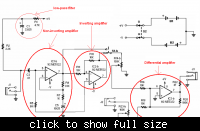PG1995
Full Member level 5

- Joined
- Apr 18, 2011
- Messages
- 248
- Helped
- 1
- Reputation
- 2
- Reaction score
- 1
- Trophy points
- 1,298
- Activity points
- 3,758
Hi
If you find that this query doesn't belong here, then please move it to the section you deem appropriate. Thank you.
I don't know every time I open an electronics book I get very much afraid after looking at those circuits. As an example have a look here:
**broken link removed**
How do you keep track of such complicated and complex circuits when solving them at school? What is your advice for me to overcome this fear? Sometimes, I simply slip into depression after looking at those circuits in the book. Please advise me what to do. When you were at school how you kept the track and solved the circuit. With simple circuits like this one:
http://gangles.ca/images/SimpleCircuit.jpg
It is fairly easy to imagine what's going on in the wires and how electrons etc. are moving. In other words one can create a mental picture for such a simple circuit. But what about those fearful circuits? Please help me.
If you find that this query doesn't belong here, then please move it to the section you deem appropriate. Thank you.
I don't know every time I open an electronics book I get very much afraid after looking at those circuits. As an example have a look here:
**broken link removed**
How do you keep track of such complicated and complex circuits when solving them at school? What is your advice for me to overcome this fear? Sometimes, I simply slip into depression after looking at those circuits in the book. Please advise me what to do. When you were at school how you kept the track and solved the circuit. With simple circuits like this one:
http://gangles.ca/images/SimpleCircuit.jpg
It is fairly easy to imagine what's going on in the wires and how electrons etc. are moving. In other words one can create a mental picture for such a simple circuit. But what about those fearful circuits? Please help me.





